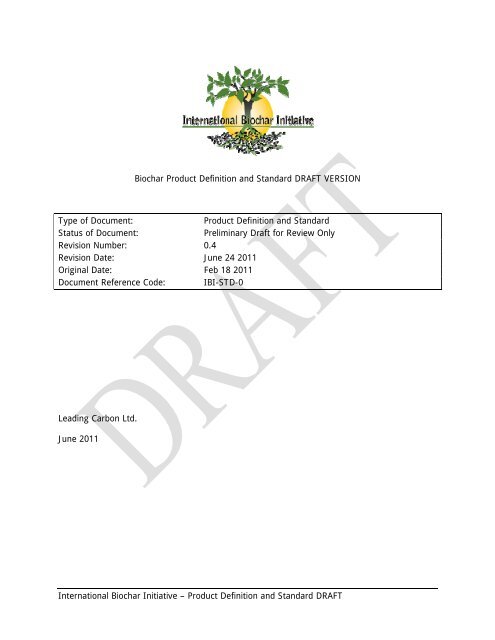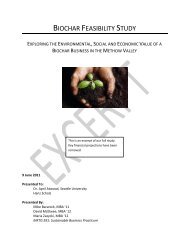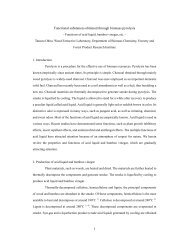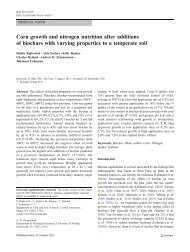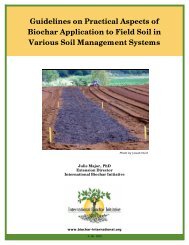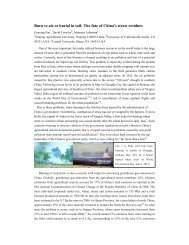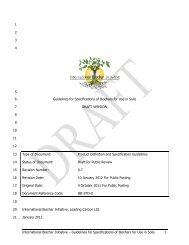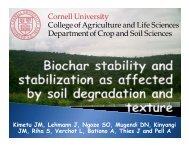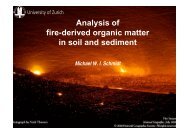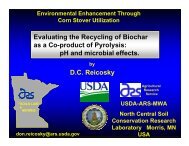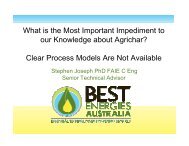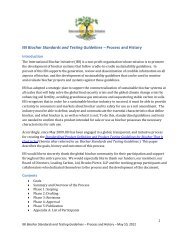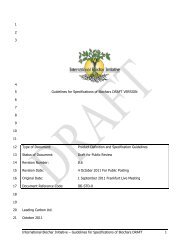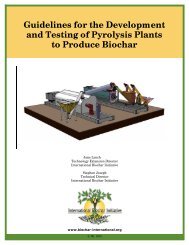International Biochar Initiative â Product Definition and Standard ...
International Biochar Initiative â Product Definition and Standard ...
International Biochar Initiative â Product Definition and Standard ...
You also want an ePaper? Increase the reach of your titles
YUMPU automatically turns print PDFs into web optimized ePapers that Google loves.
<strong>Biochar</strong> <strong>Product</strong> <strong>Definition</strong> <strong>and</strong> St<strong>and</strong>ard DRAFT VERSION<br />
Type of Document:<br />
<strong>Product</strong> <strong>Definition</strong> <strong>and</strong> St<strong>and</strong>ard<br />
Status of Document:<br />
Preliminary Draft for Review Only<br />
Revision Number: 0.4<br />
Revision Date: June 24 2011<br />
Original Date: Feb 18 2011<br />
Document Reference Code: IBI-STD-0<br />
Leading Carbon Ltd.<br />
June 2011<br />
<strong>International</strong> <strong>Biochar</strong> <strong>Initiative</strong> – <strong>Product</strong> <strong>Definition</strong> <strong>and</strong> St<strong>and</strong>ard DRAFT
Disclaimer<br />
This document has been prepared with the intent of providing the public with a st<strong>and</strong>ardized<br />
method for classifying <strong>Biochar</strong>s with relevant, reliable <strong>and</strong> measurable characteristics. In no way<br />
shall the IBI or its associates be responsible for the use or misuse of information <strong>and</strong> guidance<br />
provided in this document.<br />
The benefits of a given biochar product can vary widely with the combination of crop, soil <strong>and</strong><br />
climate factors. This st<strong>and</strong>ard document makes no claims regarding the potential benefits of<br />
any given biochar in any particular application. Caution <strong>and</strong> careful investigation is warranted<br />
when selecting biochar for an application.<br />
The IBI <strong>Biochar</strong> <strong>Product</strong> <strong>Definition</strong> <strong>and</strong> St<strong>and</strong>ard is intended to be a living document. This<br />
document is subject to continuous updates <strong>and</strong> modification as the science <strong>and</strong> body of<br />
knowledge surrounding biochars continues to evolve. Please ensure that you are using the<br />
most up-to-date version.<br />
Foreword<br />
This <strong>Biochar</strong> <strong>Product</strong> <strong>Definition</strong> <strong>and</strong> St<strong>and</strong>ard has been developed through the <strong>International</strong><br />
<strong>Biochar</strong> <strong>Initiative</strong> with the collaboration of a wide variety of industry experts on an international<br />
level.<br />
This <strong>Biochar</strong> <strong>Product</strong> <strong>Definition</strong> <strong>and</strong> St<strong>and</strong>ard was created with the intent to encourage further<br />
development of the biochar industry. This shall be accomplished through achieving more<br />
consistent levels of product quality <strong>and</strong> providing st<strong>and</strong>ardized information regarding the use,<br />
characterisation, <strong>and</strong> benefits of biochar. Along with this product definition <strong>and</strong> quality<br />
st<strong>and</strong>ard, this document has been developed to ensure consumers have more consistent access<br />
to information regarding the quality <strong>and</strong> physical properties of biochar.<br />
The <strong>Biochar</strong> <strong>Product</strong> St<strong>and</strong>ard project approach is designed to support an IBI certification<br />
program. The st<strong>and</strong>ard can also then be leveraged into the various national <strong>and</strong> regional<br />
product st<strong>and</strong>ards bodies, as may be appropriate. By starting with an internal IBI process, the<br />
discussion can be focused among experts in the field, ensuring an efficient path from concept to<br />
final product, <strong>and</strong> addressing the needs of a broad range of biochar producers <strong>and</strong> users.<br />
The proposed st<strong>and</strong>ard, <strong>and</strong> living document development process relies on the following<br />
principles:<br />
<br />
<br />
<br />
Build from congruence in best practice guidance for st<strong>and</strong>ards development (ISO, ASTM,<br />
IEEE);<br />
Strict adherence to process required to ensure that the collaborative effort yields<br />
appropriate results efficiently.<br />
Engage the knowledgeable <strong>and</strong> diverse stakeholder group active in the biochar industry;<br />
<strong>International</strong> <strong>Biochar</strong> <strong>Initiative</strong> – <strong>Product</strong> <strong>Definition</strong> <strong>and</strong> St<strong>and</strong>ard DRAFT
Organize an independent review committee with broad stakeholder representation<br />
(project developers, ENGOs, Researchers, etc.).<br />
Rely on existing infrastructure <strong>and</strong> capacity within IBI for leadership <strong>and</strong> administration<br />
of initiative;<br />
Provide oversight to st<strong>and</strong>ards development process.<br />
Formalize <strong>and</strong> validate st<strong>and</strong>ard development <strong>and</strong> review process.<br />
The participants charged with the development of the st<strong>and</strong>ardization of <strong>Biochar</strong> have been<br />
divided into two working groups.<br />
The working groups have been organized as follows:<br />
Phase 1: Initial review of document formatting <strong>and</strong> characterisation criteria<br />
Working Group #1:<br />
North America/South America/Africa<br />
Jim Amonette, United States<br />
Jason Aramburu, United States<br />
Louis de Lange, South Africa<br />
Mariam Ekebafe, Nigeria<br />
Johannes Lehmann, United States<br />
Kim Magrini, United States<br />
Hugh McLaughlin, Canada<br />
René Pigeon, Canada<br />
Joseph Pignatello, United States<br />
Miguel Rodriguez, Brazil<br />
Rogerio Traballi, Brazil<br />
Sunguo Wang, Canada<br />
Working Group #2:<br />
Asia/Europe/Australia/New Zeal<strong>and</strong><br />
Marta Camps, New Zeal<strong>and</strong><br />
Thomas Harttung, Denmark<br />
Michael Hayes, Irel<strong>and</strong><br />
Stephen Joseph, Australia<br />
Rupam Kataki, India<br />
Guitong Li, China<br />
Franco Miglietta, Italy<br />
Amran Salleh, Malaysia<br />
Yoshiyuki Shinogi, Japan<br />
Balwant Singh, Australia<br />
Saran Sohi, United Kingdom<br />
Lukas Van Zwieten, Australia<br />
Phase 2: Live in-depth discussion of characterisation criteria <strong>and</strong> reporting levels selection<br />
Marta Camps, New Zeal<strong>and</strong><br />
Stephen Joseph, Australia<br />
Johannes Lehmann, United States<br />
Cordner Peacocke, United Kingdom<br />
Michael Sesko, United States<br />
Saran Sohi, United Kingdom<br />
Edward Someus, Sweden/Hungary (EU)<br />
<strong>International</strong> <strong>Biochar</strong> <strong>Initiative</strong> – <strong>Product</strong> <strong>Definition</strong> <strong>and</strong> St<strong>and</strong>ard DRAFT
Table of Contents<br />
Disclaimer 2<br />
Foreword 2<br />
Table of Contents 4<br />
1 Scope 1<br />
2 Effective Date 1<br />
3 References 1<br />
4 Terms <strong>and</strong> <strong>Definition</strong>s 2<br />
5 Feedstock Material <strong>and</strong> <strong>Biochar</strong> <strong>Product</strong>ion 5<br />
5.1 General feedstock material requirements 5<br />
5.2 Feedstock material reporting 6<br />
5.3 General <strong>Biochar</strong> process requirements 6<br />
6 <strong>Biochar</strong> <strong>Product</strong> Classification 7<br />
6.1 Class I (Basic) 1<br />
6.2 Class II (Improved-Basic) 2<br />
6.3 Class III (Advanced) 4<br />
6.4 Class IV (Exemplary) 5<br />
6.5 Class 1-V (Basic – Virgin Feedstocks) 6<br />
6.6 Class 2-V (Basic – Virgin Feedstocks) 7<br />
6.7 Class 3-V (Basic – Virgin Feedstocks) 7<br />
7 <strong>Product</strong> Marking <strong>and</strong> Instructions 8<br />
7.1 IBI Marking General Requirements 8<br />
7.2 <strong>Product</strong> information requirements 8<br />
7.3 Special instruction 8<br />
8 Conformity <strong>and</strong> Record Keeping 8<br />
Appendix 1 – Marking <strong>and</strong> Labeling Examples 10<br />
<strong>International</strong> <strong>Biochar</strong> <strong>Initiative</strong> – <strong>Product</strong> <strong>Definition</strong> <strong>and</strong> St<strong>and</strong>ard DRAFT
1 Scope<br />
This st<strong>and</strong>ard establishes testing, measurement, <strong>and</strong> reporting methods, <strong>and</strong> markings for the<br />
product characteristics of concern for <strong>Biochar</strong> as an agent for soil improvement, remediation of<br />
soil pollution or protection against soil pollution <strong>and</strong> as an avenue for carbon sequestration.<br />
This st<strong>and</strong>ard does not prescribe appropriate uses for biochar products, nor provide limitations<br />
on what biochar can or should be used for.<br />
Different feedstocks <strong>and</strong> hence differentiated testing requirements of biochar are defined in this<br />
st<strong>and</strong>ard as means for subjugation <strong>and</strong> classification of biochar products.<br />
This st<strong>and</strong>ard does not provide limits or terms for defining the sustainability, or carbon<br />
sequestration ability of a biochar product on a life cycle analysis basis, be it for a certification<br />
scheme or otherwise.<br />
2 Effective Date<br />
The effective date of this st<strong>and</strong>ard is targeted to be [October 1 2011]. The trail <strong>and</strong> comment<br />
period is tentatively scheduled for late summer 2011.<br />
3 References<br />
[identify here all reference documents or st<strong>and</strong>ards identified as part of or support to<br />
this document]<br />
AA or ICP total K??<br />
ASTM 1510-09 Iodine Method; Compares the relative surface area of biochar (Mianowski<br />
et al., 2007)<br />
ASTM D1762<br />
ASTM D4096-91 (2009) St<strong>and</strong>ard Test Method for total suspended particulate matter in<br />
atmosphere (high volume sample methodology)<br />
ASTM D7439-08 Determining elements in particulate matter ICP-Mass Spectrometer<br />
AOAC Official Methods for assessing Fertiliser NPK<br />
Butane Adsorption Activity Test<br />
Dioxin <strong>and</strong> Furan TEQ OMS tests (chlorine surrogate for Dioxin)<br />
Dumas combustion, after removal of carbonate C<br />
EU Fertiliser Regulations (2007)<br />
McShields Method<br />
Method R&H 3A1 (Rayment <strong>and</strong> Higginson 1992) Indicates soluble cations <strong>and</strong> anions<br />
Method 19A1 (Rayment <strong>and</strong> Higginson 1992) testing carbonate equivalent -Expressed as<br />
a percentage of CaCO3<br />
NSW EPA230800d (EPA Compost Guidelines Public Consultation (2009) for Grade A & B<br />
OECD Germination inhibition is tested against three test species using OECD st<strong>and</strong>ard<br />
soil (OECD 2004). Method description in Van Zwieten et al., 2009.<br />
<strong>International</strong> <strong>Biochar</strong> <strong>Initiative</strong> – <strong>Product</strong> <strong>Definition</strong> <strong>and</strong> St<strong>and</strong>ard DRAFT<br />
1
OECD Toxicity testing conducted using the Organisation for Economic Co-operation <strong>and</strong><br />
Development (OECD) earthworm avoidance method (OECD, 1984) as described in Van<br />
Zwieten et al., 2004. <strong>Biochar</strong> is applied into OECD st<strong>and</strong>ard soil at a rate of 1% w/w,<br />
with 10 replicates.<br />
An Update of Ontario’s Compost Guideline <strong>and</strong> Regulatory Framework (EBR Registry Number<br />
010-6658).<br />
Rayment & Higginson 1992, Australian Laboratory H<strong>and</strong>book of soil <strong>and</strong> water chemical<br />
methods. Inkata Press.<br />
Spanish Compost Guidelines Grades A & B<br />
NPK Analysis<br />
Proximate Analysis<br />
Progressive Sieving<br />
Sample weight loss through drying (oven-drying moisture content sampling).<br />
Saturation paste extract method<br />
Thermogravimetric Analysis<br />
USEPA Methodology 23<br />
USEPA Methodology 8290<br />
CCME SQG Soil Quality Guidelines<br />
TCLP Toxicity Characteristic Leaching Procedure<br />
4 Terms <strong>and</strong> <strong>Definition</strong>s<br />
[identify here all technical terms that may not be clear or may have subjective definitions]<br />
Anthropogenic Carbon – Carbon which has not participated in the current or recent biosphere,<br />
(e.g. fossilized carbon (petroleum, natural gas, etc.)) <strong>and</strong> is currently being used in<br />
anthropogenic activities (e.g. production of energy, creation of plastics, etc.). When released to<br />
the atmosphere, anthropogenic carbon has an associated CO 2 equivalence which can be<br />
assigned based on the molecular form in which the carbon is released (e.g. CO 2 , CH 4 , etc.).<br />
Ash – The solid mineral fraction of biomass or organic material that is not combustible. Ash may<br />
remain as a fixed solid after combustion of an organic substance, or it may be entrained as solid<br />
particulate matter in the exhaust gases from combustion.<br />
<strong>Biochar</strong> – A solid carbonaceous material obtained from thermally degrading organic material<br />
following carbonisation. <strong>Biochar</strong> may be added to soils with the intention to improve soil<br />
functions <strong>and</strong> to reduce emissions from organic material that would otherwise naturally degrade<br />
to greenhouse gases. <strong>Biochar</strong> has appreciable carbon sequestration value. These properties are<br />
measureable <strong>and</strong> verifiable in a characterisation scheme, or in a carbon emission offset<br />
protocol.<br />
Biogenic Carbon – Carbon that participates in the current biosphere. Biogenic carbon has a CO 2<br />
equivalence of zero, because it originates from biomass sources as living, recently living or byproducts<br />
of living organisms. Biogenic carbon results from the activity, or life processes of living<br />
<strong>International</strong> <strong>Biochar</strong> <strong>Initiative</strong> – <strong>Product</strong> <strong>Definition</strong> <strong>and</strong> St<strong>and</strong>ard DRAFT<br />
2
organisms. Examples of biogenic carbon include constituents or secretions of plants <strong>and</strong><br />
animals, such as woody material, fermentation by-products, <strong>and</strong> manure; among others.<br />
Biomass –Biological material produced by living or recently living organisms. Biomass does not<br />
include petroleum related resources from ancient or fossilized biological material. Biomass<br />
carbon is thus considered biogenic as opposed to anthropogenic carbon.<br />
Carbonisation – The process of converting biomass or organic material into biochar <strong>and</strong>/or<br />
charcoal through thermal degradation. The process involves a combination of time, heat <strong>and</strong><br />
pressure exposure factors that can vary between processors, equipment <strong>and</strong> feedstocks.<br />
Char – any solid product of pyrolysis or combustion, including that from natural fires, gasifier<br />
operations, coal burning facilities, etc.<br />
Contaminant – An undesirable material in a biochar or biochar feedstock that degrades the<br />
quality or usefulness of the final <strong>Biochar</strong> product. Contaminants may or may not be toxic.<br />
Diluent / Dilutant – A material derived from either anthropogenic carbon sources (e.g., plastics)<br />
or inorganic sources (e.g. clays, metals, etc.) that are mixed with the organic material prior to<br />
pyrolysis processing. These materials will not carbonise in an equivalent fashion to the organic<br />
materials, when submitted to pyrolysis.<br />
Fast Pyrolysis -<br />
Feedstock material – the material undergoing the pyrolysis or carbonisation process to create<br />
biochar. Typically for biochar, the feedstock material consists of organic material, but may also<br />
contain diluents.<br />
Flash Pyrolysis—a type of slow-pyrolysis process conducted at 10 atmospheres pressure that is<br />
complete in about 30 minutes (developed by Dr. Michael Antal at the University of Hawaii)<br />
Gasification -<br />
***Good Carbonisation Practices – ensure that the biochar production process is optimised to<br />
meet local emission <strong>and</strong> OHS st<strong>and</strong>ards,while minimising GHG emissions <strong>and</strong> energy<br />
consumption.<br />
Highest Treatment Temperature (HTT) – The maximum temperature to which the feedstock<br />
<strong>and</strong> biochar are subject during the pyrolysis or carbonisation process.<br />
Holding Time – The time a feedstock is held within the pyrolitic temperature range during its<br />
pyrolysis. This time is a characteristic parameter of pyrolysis process.<br />
Heating Rate – The rate at which a feedstock is heated to the pyrolitic temperature range when<br />
it is undergoing pyrolysis. This rate is a characterisitic parameter of the pyrolysis process.<br />
<strong>International</strong> <strong>Biochar</strong> <strong>Initiative</strong> – <strong>Product</strong> <strong>Definition</strong> <strong>and</strong> St<strong>and</strong>ard DRAFT<br />
3
Hydrothermal Conversion —a process in which wet biomass is heated for several hours between<br />
about 180°C <strong>and</strong>250°C <strong>and</strong> autogenous pressure.<br />
Labile Carbon – the portion of carbon in biochar after pyrolysis, which is likely to be released to<br />
the environment in less than 1 year. It is likely that once the labile carbon is released to the<br />
environment, it will partake in chemical or biological reactions in the environment to be<br />
ultimately converted to carbon dioxide or methane in the atmosphere.<br />
Manufacturer – The party or parties who take responsibility for processing the feedstock<br />
materials into biochar, acquiring appropriate labelling, <strong>and</strong> testing of the biochar properties.<br />
Municipal Solid Waste (MSW) – Domestic or small commercial non-hazardous wastes. MSW<br />
includes food wastes, yard wastes, containers <strong>and</strong> product packaging, <strong>and</strong> other miscellaneous<br />
inorganic wastes from residential, commercial, institutional <strong>and</strong> industrial sources. Municipal<br />
solid waste may contain biodegradable components (e.g. food scraps, coffee grounds, etc.),<br />
recyclable material (paper, glass, certain plastics, etc.), inert waste (e.g. construction <strong>and</strong><br />
demolition waste, metal scrap, wall board, empty containers, etc.), composite wastes (toys,<br />
fabrics, etc.), domestic hazardous waste (medication, e-waste, paints, lightbulbs, batteries etc.)<br />
sludge (e.g. from waste treatment plants, water supply treatment plants, or air pollution control<br />
facilities (e.g., scrubber sludge)). Other discarded material, including solid, semi-solid, liquid, or<br />
contained gaseous material resulting from community activities can also be found in MSW. This<br />
st<strong>and</strong>ard is only concerned with non-hazardous fractions of MSW. It is the manufacturer’s<br />
responsibility to ensure that biochar feedstock materials are free of hazardous materials.<br />
Organic Material – Biological material derived from, or produced by living, or recently living<br />
organisms. This material can be ‘unprocessed’ or ‘processed’. ‘Unprocessed material’ is living<br />
material, or recently living material, (biomass) that has not gone through an anthropic chemical<br />
modification (e.g., wood chips). ‘Processed material’ is recently living material that has been<br />
chemically modified by anthropic processes (e.g., paper sludge, manure). This document<br />
recognizes that other definitions of “organic” exist such as those of organic chemistry. The IBI<br />
<strong>Biochar</strong> <strong>Product</strong> <strong>Definition</strong> <strong>and</strong> St<strong>and</strong>ard has opted to define organic only as it pertains to<br />
biogenically-sourced materials, <strong>and</strong> not with a wider chemical definition.<br />
Pyrolysis –A thermochemical decomposition of organic material at elevated temperatures in the<br />
absence of oxygen.<br />
Pyrolitic Gasification -<br />
Recalcitrant Carbon – the portion of carbon which will likely remain in the biochar for more than<br />
100 years after incorporation into soil or a final storage. This carbon is not likely to be<br />
converted to carbon dioxide in the atmosphere.<br />
Slow Pyrolysis -<br />
<strong>International</strong> <strong>Biochar</strong> <strong>Initiative</strong> – <strong>Product</strong> <strong>Definition</strong> <strong>and</strong> St<strong>and</strong>ard DRAFT<br />
4
Soil Functions – Soil functions are defined by the proposal for a European Soil Framework<br />
Directive COM(2006)232, as follows: “(i) biomass production, including in agriculture <strong>and</strong><br />
forestry; (ii) storing, filtering <strong>and</strong> transforming nutrients, substances <strong>and</strong> water; (iii) biodiversity<br />
pool, such as habitats, species <strong>and</strong> genes; (iv) physical <strong>and</strong> cultural environment for humans<br />
<strong>and</strong> human activities; (v) source of raw materials; (vi) acting as carbon pool; <strong>and</strong> (vii) archive<br />
of geological <strong>and</strong> archeological heritage.”. In this product definition <strong>and</strong> st<strong>and</strong>ard document, we<br />
will focus on environmental <strong>and</strong> production functions of biochar in soils.<br />
Torrefaction—a process whereby dry biomass is heated to temperatures in the range of 200-<br />
325°C to release any remaining moisture, to increase its density <strong>and</strong> to increase its energy<br />
density.<br />
[DRAFT NOTES TO WGs: PLEASE FEEL FREE TO PROVIDE MORE TERMS AND THEIR<br />
DEFINITIONS OR REVISE THE EXSITING DEFINTIONS PROVIDED]<br />
5 Feedstock Material <strong>and</strong> <strong>Biochar</strong> <strong>Product</strong>ion<br />
5.1 General feedstock material requirements<br />
The materials used as feedstocks to biochar processes have direct impacts on the nature <strong>and</strong><br />
quality of the resulting biochar <strong>and</strong> shall have the following properties:<br />
<br />
1 Be of a biomass origin with little chemical or physical changes imposed, such that the<br />
original identity of the material is still visibly understood.<br />
Examples include but are not limited to: wood chips, corn stover, rice <strong>and</strong> peanut hulls, tree<br />
bark, <strong>and</strong> forestry residues.<br />
<br />
1 OR be a waste material or by-product of other value generation processes <strong>and</strong> not<br />
resulting from the direct destruction of biomass systems or conversion of l<strong>and</strong> use type<br />
specifically for the generation of <strong>Biochar</strong> feedstock material.<br />
Examples include but are not limited to paper mill sludge, animal manure, natural rubbers,<br />
organic fractions of municipal <strong>and</strong> agricultural wastes. Non-biotic fractions of waste (i.e.<br />
plastics) are considered diluents to a <strong>Biochar</strong>.<br />
<br />
2 Be of suitable physical <strong>and</strong> chemical characteristics for the pyrolysis process through<br />
which it is intended to undergo.<br />
Examples include but are not limited to particle or grain size, moisture content,<br />
flammability, sulphur content<br />
<br />
3 Be free of any potentially harmful levels of contaminant<br />
Examples include but are not limited to wood preservatives or leaded paint on waste wood<br />
<br />
4 Have no more than [20%] diluents<br />
<strong>International</strong> <strong>Biochar</strong> <strong>Initiative</strong> – <strong>Product</strong> <strong>Definition</strong> <strong>and</strong> St<strong>and</strong>ard DRAFT<br />
5
Examples include but are not limited to petroleum products, rubber, PVC, etc.<br />
5.2 Feedstock material reporting<br />
The feedstock material(s) used to generate a biochar shall be declared by the manufacturer as<br />
discussed in Section 7.2.<br />
**Classification for feedstock materials required for product classification<br />
5.3 General <strong>Biochar</strong> process requirements<br />
The processes used to generate a biochar from the feedstock material shall:<br />
<br />
<br />
<br />
<br />
Provide a means to control the rate <strong>and</strong> extent to which the carbonisation process<br />
proceeds <strong>and</strong> therefore the residence time of feedstock in the process.<br />
Provide for a means of escape [<strong>and</strong> destruction] for air pollutants, particulates, volatile<br />
gases <strong>and</strong> derivatives from the feedstock / biochar material in a safe, effective <strong>and</strong><br />
reliable fashion during the pyrolysis process. The syngas or off-gas should be captured<br />
<strong>and</strong> at the minimum flared but optimally used as a source of energy to offset fossil fuels.<br />
The plant itself should comply with local emission <strong>and</strong> OHS st<strong>and</strong>ards.<br />
Provide a mechanism to safely <strong>and</strong> effectively arrest the pyrolysis process. The method to<br />
safely arrest the process must be an active form of suppression, such that it is capable of<br />
stopping pyrolysis of feedstock already undergoing thermal conversion. Discontinuing the<br />
supply of feedstock is not considered an active method for stopping the pyrolysis process.<br />
Maintain a desired level of consistency of the biochar production to the extent possible by<br />
limiting variations in the process conditions relative to variations in the operating<br />
environment <strong>and</strong> feedstock variability <strong>and</strong> report significant variations in consistency as<br />
described in Section 8.<br />
Further (optional) recommendations include:<br />
<br />
<br />
<br />
<br />
<br />
<br />
<strong>Biochar</strong> production shall follow all applicable laws of the country in which it occurs, <strong>and</strong><br />
shall endeavour to follow all international treaties relevant to thermal processes to which<br />
the relevant country is a party.<br />
<strong>Biochar</strong> production shall comply with local regulatory requirements that govern utilisation<br />
of the source material <strong>and</strong> production of volatile <strong>and</strong> particulate emissions.<br />
<strong>Biochar</strong> production <strong>and</strong> utilisation shall contribute to climate change mitigation by<br />
reducing GHG emissions (compared to fossil fuels) <strong>and</strong> converting labile carbon into more<br />
stable forms of carbon, including emission reductions along the complete supply chain.<br />
<strong>Biochar</strong> production shall avoid negative impacts on ecosystems, <strong>and</strong> areas human health.<br />
<strong>Biochar</strong> production shall optimize surface <strong>and</strong> groundwater resource use, including<br />
minimizing contamination or depletion of these resources, <strong>and</strong> shall not violate existing<br />
formal <strong>and</strong> customary water rights.<br />
<strong>Biochar</strong> production shall not violate l<strong>and</strong> rights.<br />
<strong>International</strong> <strong>Biochar</strong> <strong>Initiative</strong> – <strong>Product</strong> <strong>Definition</strong> <strong>and</strong> St<strong>and</strong>ard DRAFT<br />
6
6 <strong>Biochar</strong> <strong>Product</strong> Classification<br />
As per the descriptions given in this section, biochar products shall be classified <strong>and</strong> labelled<br />
such that the relevant parameters can be made known to users of biochar.<br />
The classification scheme does not provide any insight towards the applications of any biochar<br />
product, as the onus is on the user to determine if a biochar is suitable given the soil<br />
conditions, climate, etc. to which he/she intends to apply the biochar. The classification scheme<br />
works to:<br />
<br />
<br />
Provide a uniform information presentation scheme in which a biochar user would be<br />
able to fairly compare <strong>and</strong> assess the properties of different <strong>Biochar</strong>s <strong>and</strong> determine if<br />
any particular <strong>Biochar</strong> is suitable for their intended application.<br />
Incrementally heighten the requirements of general quality, so that a higher class<br />
provides more comprehensive underst<strong>and</strong>ing of the contents included in the product as<br />
well as a lower probability of adverse effects on soil functions when used properly.<br />
Higher class ratings do not imply that any one product is more suitable than others for any<br />
particular application.<br />
The proposed definitions of the classes are given in the following subsections. Class<br />
requirements are cumulative meaning Class I has the least requirements, <strong>and</strong> each subsequent<br />
class has incremental requirements in addition to the previous requirements. Error! Reference<br />
source not found. shows the relationship of requirements for each class.<br />
Each product shall be tested once yearly for each feedstock <strong>and</strong> process combination, after<br />
initial proof of consistent product quality is obtained. When a new feedstock material is added<br />
to a process, the classification testing for a <strong>Biochar</strong> shall need to be repeated. When a new<br />
process is implemented on a feedstock, the classification testing for a <strong>Biochar</strong> shall be repeated.<br />
Requirement <strong>Definition</strong>s:<br />
Advanced Soil Enhancement Properties: sorption activity, cation exchange capacity<br />
Advanced Soil Toxicity Requirements: potentially toxic or harmful elements, <strong>and</strong> more<br />
stringent maximum allowable thresholds<br />
Basic <strong>Biochar</strong> Characterisation: carbon stability, total ash <strong>and</strong> moisture content, electrical<br />
conductivity <strong>and</strong> particle size.<br />
Basic Soil Enhancement Properties: liming value, <strong>and</strong> macro nutrient (NPK) content<br />
Basic Soil Toxicity Requirements: potentially toxic or harmful elements, with maximumallowable<br />
content thresholds<br />
<strong>International</strong> <strong>Biochar</strong> <strong>Initiative</strong> – <strong>Product</strong> <strong>Definition</strong> <strong>and</strong> St<strong>and</strong>ard DRAFT<br />
7
Heterogenous feedstock: A biochar feedstock from potentially multiple, or unknown sources.<br />
These may include biomass, municipal solid waste, manure, pulp & paper mill waste, etc.<br />
Improved Toxicity Requirements: more stringent measures of micronutrients, heavy metals<br />
<strong>and</strong> other potentially toxic element concentrations (e.g. PCBs)<br />
Improved Soil Enhancement Properties: cation exchange capacity, available moisture/<br />
moisture holding capacity<br />
Persistence in Soil: rate of oxidation<br />
Physical Property Reporting: particle size distribution, moisture content, total carbon, bulk<br />
density, electrical conductivity,<br />
Specific Properties for Soil <strong>and</strong> Water Remediation:<br />
Vegetative & Invertebrate Vigour: germination inhibition <strong>and</strong> earthworm avoidance tests<br />
Virgin Feedstock: A biochar feedstock from a single, known, <strong>and</strong> accounted-for biomass<br />
origin (e.g. corn stover, wood chips) Must be proven.<br />
<strong>International</strong> <strong>Biochar</strong> <strong>Initiative</strong> – <strong>Product</strong> <strong>Definition</strong> <strong>and</strong> St<strong>and</strong>ard DRAFT<br />
8
<strong>International</strong> <strong>Biochar</strong> <strong>Initiative</strong> – <strong>Product</strong> <strong>Definition</strong> <strong>and</strong> St<strong>and</strong>ard DRAFT<br />
9
Heterogeneous Feedstocks<br />
Virgin Feedstocks<br />
Figure 1: Class Requirements Flow Chart<br />
<strong>International</strong> <strong>Biochar</strong> <strong>Initiative</strong> – <strong>Product</strong> <strong>Definition</strong> <strong>and</strong> St<strong>and</strong>ard DRAFT<br />
1
<strong>International</strong> <strong>Biochar</strong> <strong>Initiative</strong> – <strong>Product</strong> <strong>Definition</strong> <strong>and</strong> St<strong>and</strong>ard DRAFT<br />
2
6.1 Class 1 (Basic)<br />
Class 1 biochars must meet local jurisdiction regulations, vegetative <strong>and</strong> invertebrate vigour<br />
tests, <strong>and</strong> declare basic biochar characteristics to meet the requirements of a Class 1 quality<br />
st<strong>and</strong>ard.<br />
Class 1 <strong>Biochar</strong>s shall conform to the requirements presented in the table below.<br />
Requirement Limit* Unit Test Method<br />
Local Jurisdiction<br />
Variable Assay Methodologies: Dependent<br />
Pass/Fail Variable<br />
Regulations<br />
upon local laws<br />
Vegetative <strong>and</strong><br />
Assay Pass/Fail<br />
Invertebrate Pass/Fail<br />
Vigour<br />
Earthworm<br />
OECD methodology (1984) as described by Van<br />
Pass/Fail<br />
Avoidance Test<br />
Zwieten et al. (2009)<br />
Germination<br />
OECD methodology (2004) 3 test species, as<br />
Pass/Fail<br />
Inhibition Assay<br />
described by Van Zwieten et al. (2009)<br />
Basic <strong>Biochar</strong> Thresholds/<br />
Characteristic-dependent<br />
Variable<br />
Characterisation Declarations<br />
C- Stability<br />
% ASTM D1762<br />
Declaration fossilized<br />
Carbon<br />
Total Ash<br />
% of total ASTM D1762<br />
Declaration<br />
mass<br />
Liming Declaration % CaCO3 Method?<br />
Moisture Content<br />
% of total ASTM D1762<br />
Declaration<br />
mass<br />
Electrical<br />
Method 3.A1 Rayment <strong>and</strong> Higginson 1992) EC of<br />
Declaration dS/m<br />
Conductivity<br />
1:5 soil/water content<br />
Particle size<br />
Diameter Progressive sieving<br />
Declare<br />
distribution<br />
(cm)<br />
Dust Lower limit 0.4 g/Nm 3 ASTM D4096-91 (2009)<br />
* Limits are expressed as ‘less than’ unless specified otherwise<br />
<strong>International</strong> <strong>Biochar</strong> <strong>Initiative</strong> – <strong>Product</strong> <strong>Definition</strong> <strong>and</strong> St<strong>and</strong>ard DRAFT<br />
1
6.2 Class 2 (ImprovedBasic)<br />
Class 2 biochars must meet basic soil toxicity assessment guidelines, report basic soil<br />
enhancement properties, <strong>and</strong> meet all Class 1 requirements to meet the requirements of a Class<br />
2 quality st<strong>and</strong>ard.<br />
Class 2 <strong>Biochar</strong>s shall conform to the requirements presented in the table below:<br />
Requirement Limit* Unit Test<br />
Basic Soil Toxicity Threshold<br />
Variable methodologies depending on property<br />
assessed<br />
mg/kg<br />
Polychorinated<br />
0.2 TM or<br />
Biphenyls<br />
TEQ<br />
[Compost Ordinance?] or [feedstock precursor?]<br />
Arsenic 20 mg/kg<br />
NSW EPA230800d (EPA Compost Guidelines Public<br />
Consultation (2009) for Grade B);<br />
EU Fertiliser Regulations (2007);<br />
Boron ???? mg/kg FIND METHODOLOGY 1.8ppm max<br />
Cadmium 5 or 2 or 1** mg/kg<br />
NSW EPA230800d (EPA Compost Guidelines Public<br />
Consultation (2009) for Grade B; or New Spanish<br />
Compost Guidelines Grade B; or EU Fertilizer<br />
Regulations (2007)<br />
Chromium (total)<br />
250 or 250 or<br />
300<br />
mg/kg<br />
Cobalt 150 mg/kg<br />
Copper<br />
375 or 300 or<br />
300<br />
mg/kg<br />
Cyanide 0.10 mg/L FIND METHODOLOGY<br />
Lead<br />
150 or 150 or<br />
125<br />
mg/kg<br />
NSW EPA230800d (EPA Compost Guidelines Public<br />
Consultation (2009) for Grade B; <strong>and</strong>/or New Spanish<br />
Guidelines for Compost, grade B; or EU Fertiliser<br />
Regulations (2007)<br />
An Update of Ontario’s Compost Guideline <strong>and</strong><br />
Regulatory Framework (EBR Registry Number 010-<br />
6658).<br />
NSW EPA230800d (EPA Compost Guidelines Public<br />
Consultation (2009) for Grade B; or Spanish Compost<br />
Guidelines Grade B; or EU Fertiliser Regulations<br />
(2007)<br />
NSW EPA230800d (EPA Compost Guidelines Public<br />
Consultation (2009) for Grade B; or Spanish Compost<br />
Guidelines Grade B; or EU Fertiliser (2007)<br />
Manganese 1.0 mg/L FIND METHODOLOGY<br />
Molybdenum 20 mg/kg<br />
An Update of Ontario’s Compost Guideline <strong>and</strong><br />
Regulatory Framework (EBR Registry Number 010-<br />
6658).<br />
Mercury 4 or 1.5 or 0.5 mg/kg<br />
NSW EPA230800d (EPA Compost Guidelines Public<br />
Consultation (2009) for Grade B; or Spanish Compost<br />
Guidelines Grade B; or EU Fertilizer Regulations<br />
(2007)<br />
N NSW EPA230800d (EPA Compost Guidelines Public<br />
Nickel<br />
125 or 90 or<br />
Consultation (2009) for Grade B; or Spanish Compost<br />
mg/kg<br />
40<br />
Guidelines Grade B; or EU Fertilizer Regulations<br />
(2007)<br />
Selenium 8 mg/kg<br />
NSW EPA230800d (EPA Compost Guidelines Public<br />
Consultation (2009) for Grade B<br />
Sodium ???? mg/kg FIND METHODOLOGY<br />
<strong>International</strong> <strong>Biochar</strong> <strong>Initiative</strong> – <strong>Product</strong> <strong>Definition</strong> <strong>and</strong> St<strong>and</strong>ard DRAFT<br />
2
Requirement Limit* Unit Test<br />
Tin 1.0 mg/L FIND METHODOLOGY<br />
Zinc 700 or 500 mg/kg<br />
NSW EPA230800d (EPA Compost Guidelines Public<br />
Consultation (2009) for Grade B; or Spanish Compost<br />
Guidelines Grade B<br />
Basic Soil<br />
Enhancement<br />
Variable depending on property<br />
Properties<br />
Liming<br />
Declaration<br />
%<br />
19A1 Rayment <strong>and</strong> Higginson (1992) Carbonate<br />
CaCo3<br />
equivalence<br />
eq.<br />
Total NPK<br />
Declaration<br />
%<br />
content<br />
St<strong>and</strong>ard Fertiliser Analysis (AOAC Official Methods)<br />
Available NPK<br />
Declaration<br />
%<br />
content<br />
St<strong>and</strong>ard Fertiliser Analysis (AOAC Official Methods)<br />
Suspended solids 100 mg/L TLCP <strong>and</strong> St<strong>and</strong>ard Methodology<br />
* Limits are expressed as ‘less than’ unless specified otherwise<br />
** where multiple tests are included, they are listed in order of appearance, <strong>and</strong> correspond to<br />
limit values reported in the same order of appearance (e.g. Cadmium: 5 = NSW EPA 230800d;<br />
2 = New Spanish Guidelines; 1 = EU Fertiliser Regulations)<br />
In addition, Class II <strong>Biochar</strong>s must meet all requirements of Class I <strong>Biochar</strong>s.<br />
<strong>International</strong> <strong>Biochar</strong> <strong>Initiative</strong> – <strong>Product</strong> <strong>Definition</strong> <strong>and</strong> St<strong>and</strong>ard DRAFT<br />
3
6.3 Class 3 (Advanced)<br />
Class 3 biochars must meet advanced soil toxicity assessment guidelines, report advanced soil<br />
enhancement properties, <strong>and</strong> meet all Class 1 <strong>and</strong> 2 requirements to meet the requirements of<br />
a Class 3 quality st<strong>and</strong>ard.<br />
Class 3 <strong>Biochar</strong>s shall conform to the requirements presented in the table below<br />
Requirement Limit* Unit Test<br />
Advanced Soil<br />
Toxicity<br />
Variable<br />
Cadmium 3 or 0.7 mg/kg<br />
Chromium (total) 100 or 70 mg/kg<br />
Copper 100 or 70 mg/kg<br />
Mercury 1 or 0.5 mg/kg<br />
Nickel 60 or 25 mg/kg<br />
Selenium 5 mg/kg<br />
Zinc 200 mg/kg<br />
Polycyclic aromatic<br />
hydrocarbons (PAH)<br />
16<br />
Furan 0.5<br />
Dioxin 0.5<br />
mg EPA<br />
PAH/kg TM<br />
ng/kg I<br />
TEQ OMS<br />
ng/kg I<br />
TEQ OMS<br />
Variable depending on property assessed<br />
NSW EPA230800d (EPA Compost Guidelines Public<br />
Consultation (2009) for Grade A; or Spanish<br />
Guidelines, Grade A<br />
NSW EPA230800d (EPA Compost Guidelines Public<br />
Consultation (2009) for Grade A; or Spanish Grade<br />
A<br />
NSW EPA230800d (EPA Compost Guidelines Public<br />
Consultation (2009) for Grade A; or Spanish Grade<br />
A<br />
NSW EPA230800d (EPA Compost Guidelines Public<br />
Consultation (2009) for Grade A; or Spanish Grade<br />
A<br />
NSW EPA230800d (EPA Compost Guidelines Public<br />
Consultation (2009) for Grade A; or Spanish Grade<br />
A<br />
NSW EPA230800d (EPA Compost Guidelines Public<br />
Consultation (2009) for Grade A<br />
NSW EPA230800d (EPA Compost Guidelines Public<br />
Consultation (2009) for Grade A; <strong>and</strong> Spanish<br />
Grade A<br />
FIND METHODOLOGY<br />
Surrogate Test?<br />
Chlorine Surrogate Test?<br />
Advanced Soil<br />
Variable depending on property<br />
Enhancement Declaration<br />
Properties<br />
Cation Exchange<br />
Conducted after elimination of soluble salts<br />
Declaration<br />
Capacity<br />
Available/<br />
Water content at -0.3 <strong>and</strong> -15 BAR (pressure plate)<br />
%<br />
Unavailable Water<br />
Crystalline Silica Based on local st<strong>and</strong>ards or best practices (?)<br />
* Limits are expressed as ‘less than’ unless specified otherwise<br />
In addition, Class III <strong>Biochar</strong>s must meet all requirements of Class II <strong>Biochar</strong>s.<br />
<strong>International</strong> <strong>Biochar</strong> <strong>Initiative</strong> – <strong>Product</strong> <strong>Definition</strong> <strong>and</strong> St<strong>and</strong>ard DRAFT<br />
4
6.4 Class 4 (Exemplary)<br />
Class 4 biochars must meet specific properties for soil <strong>and</strong> water remediation, <strong>and</strong> meet all<br />
Class 3, 2 <strong>and</strong> 1 requirements to meet the requirements of a Class 4 quality st<strong>and</strong>ard.<br />
Class 4 <strong>Biochar</strong>s shall conform to the requirements presented in the tables below:<br />
Requirement Limit* Unit Test<br />
Specific Properties<br />
for Soil <strong>and</strong> Water<br />
Remediation<br />
Sorption Activity<br />
Porosity<br />
Declaration<br />
s<br />
Surface Area<br />
CEC<br />
Moisture Retention<br />
Total Nitrogen %<br />
volume<br />
Total K %<br />
volume<br />
Total C %<br />
volume<br />
Variable<br />
Butane Test??<br />
ASTM 1510-09 Iodine Method to compare lreative<br />
surface area of biochar (Mianowski et al. 2007)<br />
FIND METHODOLOGY<br />
3A1 (Rayment & Higginson)<br />
FIND METHODOLOGY<br />
Dry/ Dumas Combustion<br />
Dry combustion, dissolution in acid, & measured with<br />
AA or ICP<br />
Dry/ Dumas Combustion<br />
Liming Value<br />
Declare<br />
Method 19A1 (Rayment <strong>and</strong> Higginson 1992) testing<br />
CaCO 3<br />
carbonate equivalent -Expressed as a percentage of<br />
eq.<br />
CaCO3<br />
O:C ratio No units Dry/ Dumas Combustion, to assess stability<br />
H:C ratio<br />
??? FIND METHODOLOGY<br />
* Limits are expressed as ‘less than’ unless specified otherwise<br />
In addition, Class IV <strong>Biochar</strong>s must meet all requirements of Class III <strong>Biochar</strong>s. OR,<br />
if from Virgin Feedstocks, Class IV <strong>Biochar</strong>s must meet all req uirements of Class<br />
3-V <strong>Biochar</strong>s.<br />
<strong>International</strong> <strong>Biochar</strong> <strong>Initiative</strong> – <strong>Product</strong> <strong>Definition</strong> <strong>and</strong> St<strong>and</strong>ard DRAFT<br />
5
6.5 Class 1V (Basic – Virgin Feedstocks)<br />
Class 1-V biochars must meet local jurisdiction regulations, vegetative <strong>and</strong> invertebrate vigour<br />
tests, <strong>and</strong> declare basic biochar characteristics to meet the requirements of a Class 1-Virgin<br />
quality st<strong>and</strong>ard.<br />
Class 1-V <strong>Biochar</strong>s shall conform to the requirements presented in the tables below:<br />
Requirement Limit Unit Test<br />
Local Jurisdiction<br />
Regulations<br />
Basic <strong>Biochar</strong><br />
Characterisation<br />
Pass/Fail<br />
Thresholds<br />
/<br />
Declaration<br />
s<br />
Variable<br />
Variable<br />
Variable Assay Methodologies: Dependent<br />
upon local laws<br />
Characteristic-dependent<br />
C- Stability<br />
% ASTM D1762; Fixed Carbon assessment<br />
Declaration fossilized<br />
Carbon<br />
Total Ash<br />
% of total ASTM D1762<br />
Declaration<br />
mass<br />
Liming Declaration % CaCO3 Method?<br />
Moisture Content<br />
% of total ASTM D1762<br />
Declaration<br />
mass<br />
Electrical<br />
Method 3.A1 Rayment <strong>and</strong> Higginson 1992) EC of<br />
Declaration dS/m<br />
Conductivity<br />
1:5 soil/water content<br />
Particle size<br />
Diameter Progressive sieving<br />
Declare<br />
distribution<br />
(cm)<br />
Dust 0.4 g/Nm 3 ASTM D4096-91 (2009)<br />
Vegetative <strong>and</strong><br />
Assay Pass/Fail<br />
Invertebrate<br />
Vigour<br />
Pass/Fail<br />
Earthworm<br />
OECD methodology (1984) as described by Van<br />
Pass/Fail<br />
Avoidance Test<br />
Zwieten et al. (2009)<br />
Germination<br />
OECD methodology (2004) 3 test species, as<br />
Pass/Fail<br />
Inhibition Assay<br />
described by Van Zwieten et al. (2009)<br />
* Limits are expressed as ‘less than’ unless specified otherwise<br />
<strong>International</strong> <strong>Biochar</strong> <strong>Initiative</strong> – <strong>Product</strong> <strong>Definition</strong> <strong>and</strong> St<strong>and</strong>ard DRAFT<br />
6
6.6 Class 2V (Basic – Virgin Feedstocks)<br />
Class 2-V biochars must declare basic soil enhancement properties, <strong>and</strong> meet all requirements<br />
of Class 1-V quality st<strong>and</strong>ards in order to meet the requirements of Class 2-Virgin biochars.<br />
Class 2-V <strong>Biochar</strong>s shall conform to the requirements presented in the tables below:<br />
Requirement Limit Test<br />
Basic Soil<br />
Enhancement<br />
Properties<br />
Liming<br />
Declaration<br />
%<br />
CaCo3<br />
eq.<br />
Variable depending on property<br />
19A1 Rayment <strong>and</strong> Higginson (1992) Carbonate<br />
equivalence<br />
Total NPK Declaration St<strong>and</strong>ard Fertiliser Analysis (AOAC Official Methods)<br />
Available NPK ???<br />
Suspended solids 100 mg/L TLCP <strong>and</strong> St<strong>and</strong>ard Methodology<br />
* Limits are expressed as ‘less than’ unless specified otherwise<br />
In addition, Class 2-V <strong>Biochar</strong>s must meet all requirements of Class 1-V <strong>Biochar</strong>s.<br />
6.7 Class 3V (Basic – Virgin Feedstocks)<br />
Class 3-V biochars must declare basic soil enhancement properties, <strong>and</strong> meet all requirements<br />
of Class 1-V <strong>and</strong> 2-V quality st<strong>and</strong>ards in order to meet the requirements of Class 3-Virgin<br />
biochars.<br />
Class 3-V <strong>Biochar</strong>s shall conform to the requirements presented in the tables below:<br />
Requirement Limit Test<br />
Advanced Soil<br />
Variable depending on property<br />
Enhancement Declaration<br />
Properties<br />
Cation Exchange<br />
Conducted after elimination of soluble salts<br />
Declaration<br />
Capacity<br />
Available/<br />
Water content at -0.3 <strong>and</strong> -15 BAR (pressure plate)<br />
%<br />
Unavailable Water<br />
* Limits are expressed as ‘less than’ unless specified otherwise<br />
In addition, Class 3-V <strong>Biochar</strong>s must meet all requirements of Class 2-V <strong>Biochar</strong>s.<br />
<strong>International</strong> <strong>Biochar</strong> <strong>Initiative</strong> – <strong>Product</strong> <strong>Definition</strong> <strong>and</strong> St<strong>and</strong>ard DRAFT<br />
7
7 <strong>Product</strong> Marking <strong>and</strong> Instructions<br />
7.1 IBI Marking General Requirements<br />
The IBI label shall be attached or included in transactional documents, packaging,<br />
advertisement or other commercial documentation associated with a <strong>Biochar</strong> product if <strong>and</strong> only<br />
if all the requirements of this st<strong>and</strong>ard are adhered to in their entirety.<br />
The IBI label shall be not be larger than [3%] of the surface on which it is included <strong>and</strong> shall<br />
not give the impression that the product has direct providence from the IBI or any of its<br />
associates. The label shall be placed in a fashion that is visible <strong>and</strong> clear, however not mistaken<br />
as the entity responsible for the production, sale or use of the <strong>Biochar</strong> product.<br />
An example of the IBI product st<strong>and</strong>ard label is included in Appendix 1<br />
7.2 <strong>Product</strong> information requirements<br />
Included with the IBI label, the manufacturer shall make available to the user, information<br />
pertaining to:<br />
<br />
<br />
<br />
<br />
<br />
<br />
The feedstock material(s)<br />
The relevant information required by class<br />
Other relevant safety concerns regarding transportation <strong>and</strong> application methods or<br />
constraints<br />
Other materials combined or otherwise mixed with the biochar (soils, fertilizers, etc.)<br />
Percentage of material within the mixture that is biochar<br />
Content (by weight or volume) of diluents within the biochar fraction.<br />
7.3 Special instruction<br />
The manufacturer shall make available to the user, instructions for suitable storage <strong>and</strong><br />
transportation methods with respect to maintaining:<br />
<br />
<br />
The safety of the users <strong>and</strong> foreseeable non-users whose presence is anticipatable in<br />
the intended or normal use of the product.<br />
The quality of the product in terms of soil safety, carbon stability, soil fertilization<br />
properties <strong>and</strong> other general properties as described in this st<strong>and</strong>ard (see Section 5)<br />
8 Conformity <strong>and</strong> Record Keeping<br />
Documentation <strong>and</strong> reporting are required by producers seeking to gain the IBI’s confidence in<br />
product st<strong>and</strong>ardization. Being a product of potentially variable feedstock, the reporting of<br />
<strong>Biochar</strong> feedstock contents, pyrolysis process <strong>and</strong> end-product quality are all necessary to<br />
<strong>International</strong> <strong>Biochar</strong> <strong>Initiative</strong> – <strong>Product</strong> <strong>Definition</strong> <strong>and</strong> St<strong>and</strong>ard DRAFT<br />
8
provide adequate assurance in end-product uniformity. As such, record keeping will be<br />
m<strong>and</strong>atory, not only for the purpose of proof-of-adequate sample testing, but also for proof of<br />
product authorization though time.<br />
Chain of custody <strong>and</strong> product traceability will require an assurance that adequate care <strong>and</strong><br />
transparency is being exercised to enable trace-back of end products to producers <strong>and</strong><br />
feedstock suppliers from end-users across the <strong>Biochar</strong> market. All levels in the <strong>Biochar</strong><br />
production <strong>and</strong> supply chain will be required to participate in record keeping in order to<br />
maintain quality assurance. For the sake of feedstock supplier <strong>and</strong> pyrolysis producer, files may<br />
be amalgamated on site if this enables more accurate <strong>and</strong> longer-term full-circle accounting.<br />
Producers <strong>and</strong> vendors will be required to maintain records in order to enable backtracking<br />
between finished product on the shelf <strong>and</strong> the pyrolysis project operators.<br />
<strong>International</strong> <strong>Biochar</strong> <strong>Initiative</strong> – <strong>Product</strong> <strong>Definition</strong> <strong>and</strong> St<strong>and</strong>ard DRAFT<br />
9
Appendix 1 – Marking <strong>and</strong> Labeling Examples<br />
An example IBI product marking is given below with the necessary product information as<br />
described in this st<strong>and</strong>ard:<br />
IBI CERTIFIED BIOCHAR PRODUCT<br />
PRODUCT TYPE: CLASS 2<br />
www.biochar-international.com<br />
FEEDSTOCK TYPE: WOODY RESIDUES, SAW DUST, BARK<br />
DENSITY: 700KG /M3<br />
CARBON SEQ. VALUE 30% BY MASS<br />
PARTICLE SIZE:<br />
5mm<br />
APPLICATION METHOD: DIRECT<br />
INGREDIENTS:<br />
50% - BIOCHAR<br />
45% - COMPOSTED SOIL MIXTURE<br />
5% - WATER<br />
APPROVAL DATE: NOV 2010<br />
APPROVAL INDEX: 123456789<br />
An additional option for labelling could appear like this (below), with Class labelling at the<br />
bottom, along with IBI website information. This will more easily fit the 3% rule.<br />
IBI Certified <strong>Biochar</strong><br />
<strong>Product</strong><br />
www.biochar-international.org<br />
2-V<br />
<strong>International</strong> <strong>Biochar</strong> <strong>Initiative</strong> – <strong>Product</strong> <strong>Definition</strong> <strong>and</strong> St<strong>and</strong>ard DRAFT<br />
10


